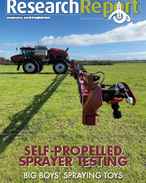This article is 6 years old. Images might not display.
Agriculture Victoria Leading Chemical Standards officer, Felicity Collins, said land managers need to properly assess suitable spray conditions and monitor and consider the weather conditions.
"Vegetable crops, such as tomatoes are extremely sensitive to spray drift damage from herbicides," Collins said.
"Even a very small amount of herbicide drift can result in serious crop losses. Tomato crops are rotated each year and could be planted in a paddock near your farm this spring or summer.
"Land managers are strongly encouraged to talk to their neighbours to let them know the location of their crops and discuss chemical use practices that minimise the risk of spray drift damage."
Collins said all herbicides, including amine salt formulations, are capable of significant drift and chemical users should not be complacent.
Spray drift that causes damage to or contaminates another person's crop is an offence in Victoria, therefore caution must be taken when herbicides are used.
Recommendations include:
*Use the coarsest droplet size possible, lower speeds and keep boom height to a minimum.
*Always read and follow the product label directions. Some labels specify a minimum droplet size, wind speed range, buffer zones and boom height that legally must be followed by the user.
*Spray in appropriate weather conditions. Do not spray when a surface temperature inversion is present, such as at dawn and night. Wind speed, wind direction, humidity and temperature all play a key role in reducing the potential of drift. Spray when the wind is blowing away from sensitive crops and do not spray when little, no wind or variable winds exist.
*Leave a buffer zone between the target area and sensitive crop where no chemical is applied. This allows droplets to settle before potentially leaving your farm.
For more information on managing spray drift, visit www.agriculture.vic.gov.au/chemicaluse or contact an Agriculture Victoria chemical standards officer on 136 186.























